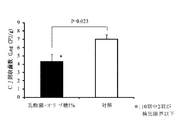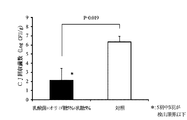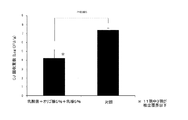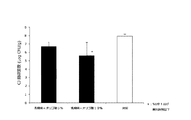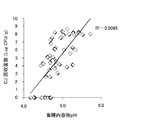JP2012180304A - Drink for controlling campylobacter infection of chicken - Google Patents
Drink for controlling campylobacter infection of chicken Download PDFInfo
- Publication number
- JP2012180304A JP2012180304A JP2011043933A JP2011043933A JP2012180304A JP 2012180304 A JP2012180304 A JP 2012180304A JP 2011043933 A JP2011043933 A JP 2011043933A JP 2011043933 A JP2011043933 A JP 2011043933A JP 2012180304 A JP2012180304 A JP 2012180304A
- Authority
- JP
- Japan
- Prior art keywords
- chickens
- drinking water
- campylobacter
- lactic acid
- acid bacteria
- Prior art date
- Legal status (The legal status is an assumption and is not a legal conclusion. Google has not performed a legal analysis and makes no representation as to the accuracy of the status listed.)
- Pending
Links
Images
Abstract
Description
本発明は、養鶏場における鶏のカンピロバクター汚染を制御する飲料に関する。 The present invention relates to a beverage for controlling chicken Campylobacter contamination in a poultry farm.
カンピロバクター属菌は、グラム陰性、両端又は一端に長い鞭毛を持つ微好気性の螺旋形桿菌で、家畜、家禽、伴侶動物および野生動物の消化管や生殖器などに広く分布している。
近年、カンピロバクターは先進国では小児と青年層を中心に主に食中毒による散発性下痢症から最も高率に分離され、ヨーロッパではカンピロバクターが原因である食中毒が年間約20万件発生している(非特許文献1)。日本では平成21年の食中毒発生状況によるとカンピロバクター食中毒の発生件数は345件で原因物質別で第1位となっている(厚生労働省食中毒統計)。食中毒統計に報告される事件数は実際の被害実数の氷山の一角にすぎないことも指摘されている(非特許文献2)。またカンピロバクター感染症は食中毒としてだけではなく人獣共通感染症として公衆衛生上重要なテーマの一つとなっている。また、臨床症状としては、重症度に違いはあるものの、通常は単純な急性胃腸炎として経過し、多くは数日以内に軽快するが、合併症として、ギランバレー症候群などを併発することがある。
Campylobacter is a gram-negative, microaerobic spiral gonococcus having long flagella at both ends or one end, and is widely distributed in the digestive tract and genital organs of domestic animals, poultry, companion animals and wild animals.
In recent years, Campylobacter has been isolated from sporadic diarrhea due to food poisoning mainly in children and adolescents in developed countries, and in Europe, about 200,000 cases of food poisoning caused by Campylobacter occur annually (non- Patent Document 1). According to the state of food poisoning in Japan in 2009, the number of occurrences of Campylobacter food poisoning was 345, ranking first by causative substance (Ministry of Health, Labor and Welfare Food Poisoning Statistics). It has also been pointed out that the number of incidents reported in food poisoning statistics is just the tip of the actual iceberg of actual damage (Non-Patent Document 2). Campylobacter infection is not only a food poisoning but also one of the important public health issues as a zoonotic disease. Although clinical symptoms vary in severity, they usually progress as simple acute gastroenteritis, and usually resolve within a few days, but complications may include Guillain-Barre syndrome. .
カンピロバクター食中毒の感染源としては食品、保菌動物の糞便、井戸水、未殺菌乳などが知られている。特に、先進諸国で感染源として最も重要視されているのが鶏肉で、鶏肉の汚染率は他の畜肉に比べ非常に高く、検査した鶏肉の100%が汚染されていた例も報告されている(非特許文献3)。これは、養鶏場において、鶏が高率にカンピロバクターを保菌していることに由来する(非特許文献4、5、6)。
養鶏場におけるカンピロバクター汚染が制御出来ればカンピロバクター食中毒の減少に多大な貢献ができるため、ワクチン(特許文献1参照)や生薬(特許文献2、3参照)あるいはβ−1,4−マンノビオース(特許文献4参照)などが検討されている。
鶏肉のカンピロバクター汚染の直接の原因としては、食鳥処理場における交差汚染が非常に重要である。カンピロバクター汚染鶏群の処理後にカンピロバクター非汚染鶏群を処理した場合に鶏肉がカンピロバクターに汚染される。また、まな板の上での鶏肉の解体時に汚染してしまうという二次的な汚染によることも多々ある。
Known sources of Campylobacter food poisoning include food, feces of carriers, well water, and unsterilized milk. In particular, chicken is the most important source of infection in developed countries, and the contamination rate of chicken is very high compared to other livestock, and 100% of the examined chicken has been reported to be contaminated. (Non-Patent Document 3). This originates from the fact that chickens carry Campylobacter at a high rate in poultry farms (Non-Patent
If Campylobacter contamination in the poultry farm can be controlled, it can greatly contribute to the reduction of Campylobacter food poisoning, so vaccine (see Patent Document 1) and herbal medicine (see
As a direct cause of Campylobacter contamination of chicken, cross contamination in the poultry slaughterhouse is very important. If the Campylobacter non-contaminated flock is treated after the Campylobacter contaminated flock, the chicken is contaminated by Campylobacter. It is also often due to secondary contamination that can occur when chicken is dismantled on a cutting board.
消化管には多数の細菌が腸内細菌叢を形成している。これらの腸内細菌叢の中には生体にとって有用であるとされる乳酸菌やビフィズス菌に代表される善玉菌や生体によって有害とされている悪玉菌とが存在する。消化管内において乳酸菌やビフィズス菌を増加させると、結果として悪玉菌が減少し、腸内環境が改善される。これにもとづき、乳酸菌やビフィズス菌そのものであるプロバイオティクス、乳酸菌やビフィズス菌の増殖を促進させるものとしてオリゴ糖などのプレバイオティクスまたそれらを組み合わせたシンバイオティクスが。ヒトでは健康食品または医療品として、家畜では家畜用飼料または飼料添加物として利用されている Many bacteria form the intestinal flora in the digestive tract. Among these intestinal flora, there are lactic acid bacteria that are useful for living bodies, good bacteria represented by bifidobacteria, and bad bacteria that are considered harmful by living bodies. Increasing lactic acid bacteria and bifidobacteria in the digestive tract results in a decrease in bad bacteria and an improvement in the intestinal environment. Based on this, probiotics that are lactic acid bacteria and bifidobacteria themselves, prebiotics such as oligosaccharides, and synbiotics that combine them are used to promote the growth of lactic acid bacteria and bifidobacteria. Used as a health food or medical product in humans and as a livestock feed or feed additive in livestock
養鶏関係ではプレバイオティクスであるオリゴ糖を飼料に添加して鶏に投与することにより、鶏の腸管内の善玉菌である乳酸菌やビフィズス菌の増殖を促進し、ヒトの食中毒起因菌であるサルモネラの増殖抑制に効果があるとされているが、顕著な効果は得られていない(非特許文献7)。乳酸菌を動物へ用いる例として,ラクトバシラス・ロイテリおよびラクトバシラス・クリスパータスからなる生菌剤によるサルモネラ菌の腸管定着防止(特許文献5)、抗体と乳酸菌を投与するコクジウム症予防及び治療剤(特許文献6)、強制換羽障害防止剤(特許文献7)等があるが、本発明とは使用目的が異なっている。また、カンピロバクターに対して、オリゴ糖を飼料に添加することによって増殖が抑制されたという報告(非特許文献8)もあるが、感染初期段階には増殖を遅延させる効果はあるものの既にカンピロバクターに汚染されている鶏に対してはその改善は困難なようである。 In poultry farming, oligosaccharides, which are prebiotics, are added to the feed and administered to chickens to promote the growth of lactic acid bacteria and bifidobacteria, which are good bacteria in the intestinal tract of chickens. Although it is said that it is effective in suppressing the growth of, it does not have a significant effect (Non-patent Document 7). Examples of using lactic acid bacteria for animals include prevention of intestinal colonization of Salmonella by viable agents consisting of Lactobacillus reuteri and Lactobacillus crispatus (Patent Document 5), and a preventive and therapeutic agent for coccidiosis by administering an antibody and lactic acid bacteria (Patent Document 6), Although there is a compulsory molting prevention agent (Patent Document 7) and the like, the purpose of use is different from that of the present invention. In addition, there is a report (Non-patent Document 8) that the growth was suppressed by adding oligosaccharides to the feed against Campylobacter. The improvement seems to be difficult for chickens.
鶏のカンピロバクター汚染を制御する有効な手法は確立されていない。そのため、養鶏場はカンピロバクターに汚染されたままの鶏を市場へ出荷しており、これが原因による食中毒の発生が絶えない。 An effective method for controlling chicken Campylobacter contamination has not been established. For this reason, chicken farms ship chickens that are still contaminated with Campylobacter to the market, and food poisoning due to this is constantly occurring.
本発明の目的は、鶏の体内から効率よくカンピロバクターを排除する効果を有する乳酸菌を含む飲用水の提供である。さらに養鶏場のカンピロバクター感染鶏群に対し、本飲用水を飲水投与することによりカンピロバクターを体内から排除する手法を提供することである An object of the present invention is to provide drinking water containing lactic acid bacteria having an effect of efficiently eliminating Campylobacter from the body of a chicken. Furthermore, it is to provide a method for eliminating Campylobacter from the body by drinking this drinking water to the flock of Campylobacter-infected chickens in the poultry farm
すなわち、本発明は、乳酸菌を通常の飲用水に浮遊または懸濁させた鶏用飲用水であり、好ましくはさらに腸内乳酸菌の増殖を促進するオリゴ糖を加えたものである。乳酸菌は、鶏腸内のpHを約5に維持する性状を有する菌であることが望ましく,鶏の盲腸内から常法により分離、選択が可能である。本発明に使用した分離株Lactobacillus salivarius B-22は特許微生物寄託センターへ寄託されている(受託番号:FERM P-22045)。これらの乳酸菌を最終濃度で107CFU/mL以上好ましくは108CFU/mL以上となるよう飲水に懸濁すればよい。 That is, the present invention is a drinking water for chickens in which lactic acid bacteria are suspended or suspended in normal drinking water, and preferably further added with an oligosaccharide that promotes the growth of intestinal lactic acid bacteria. The lactic acid bacterium is preferably a bacterium having a property of maintaining the pH in the chicken intestine at about 5, and can be separated and selected from the cecum of the chicken by a conventional method. The isolate Lactobacillus salivarius B-22 used in the present invention has been deposited with the Patent Microorganism Depositary (Accession Number: FERM P-22045). These lactic acid bacteria may be suspended in drinking water so that the final concentration is 10 7 CFU / mL or more, preferably 10 8 CFU / mL or more.
乳酸菌に添加するオリゴ糖は、フラクトオリゴ糖が好ましいが、特に限定されない。添加濃度が5%から10%の範囲では、濃度に比例してカンピロバクターの発育は阻止される。さらに糖分として乳糖を5%程度添加すればなおよい。本発明の飲用水は、投与期間が1日の飲水投与で持続効果が得られる特徴を有する。この特徴は、食鳥処理場へ出荷する前の作業量の軽減に貢献する。本発明により、多忙な養鶏業者にも受け入れ可能な、簡便かつ安価なカンピロバクターの汚染防止方法が提供できる。 The oligosaccharide added to lactic acid bacteria is preferably fructooligosaccharide, but is not particularly limited. When the added concentration is in the range of 5% to 10%, the growth of Campylobacter is inhibited in proportion to the concentration. Furthermore, it is better to add about 5% of lactose as a sugar. The drinking water of the present invention has a characteristic that a sustained effect can be obtained by drinking water administered for one day. This feature contributes to reducing the amount of work before shipping to the poultry processing plant. According to the present invention, it is possible to provide a simple and inexpensive method for preventing Campylobacter contamination that can be accepted by busy chicken farmers.
本発明の飲用水を出荷前の鶏に一日間飲用させるだけで,鶏の腸管に存在するカンピロバクターを長期間排除することができ、鶏のカンピロバクターに起因する食中毒の発生を防止できる。 Campylobacter present in the intestinal tract of chicken can be eliminated for a long period of time only by drinking the drinking water of the present invention to chickens before shipment for one day, and the occurrence of food poisoning due to chicken Campylobacter can be prevented.
例1
鶏の盲腸内から分離し、かつ高度にカンピロバクター・ジェジュニの発育を阻止する乳酸菌、ラクトバシラス・サリバリウス(Lactobacillu salivarius) B-22株をMRS液体培地で37℃、18時間培養し、培養菌液を7,500rpm、5分間遠心後、沈渣を水に浮遊(108CFU/mL濃度、浮遊液という。)させた。またフラクトオリゴ糖をこの浮遊液に5%濃度で添加し、試験区用の飲用水とした。
Example 1
Lactobacillu salivarius B-22, a lactic acid bacterium that isolates from the cecum of chickens and highly inhibits the growth of Campylobacter jejuni, is cultured in an MRS liquid medium at 37 ° C. for 18 hours, and the cultured bacterial solution is 7,500. After centrifugation at rpm for 5 minutes, the sediment was suspended in water (10 8 CFU / mL concentration, referred to as suspension). In addition, fructooligosaccharide was added to this suspension at a concentration of 5% to obtain drinking water for the test area.
試験1
試験区として鶏10羽、対照区として鶏10羽を用いた。4日齢時、試験区及び対照区の鶏にカンピロバクター・ジェジュニを107CFU/羽ずつ経口投与チューブを用いてそ嚢内に接種し感染させた。8日齢時、対照区の鶏に乳酸菌及びオリゴ糖を含む上記の飲用水を1日間不断飲水投与し、投与終了後に鶏を安楽死させ盲腸内容物を採材し、盲腸内のカンピロバクター・ジェジュニ生菌数の測定を行った。結果、試験区10羽の平均菌数(対数)は4.32±0.90(標準誤差:SE)
Log10CFU/gで、対照区10羽の平均菌数は7.00±0.57 (SE) Log10CFU/gであった。また両区には有意差(危険率5%)が認められた。試験区については10羽中2羽でカンピロバクター・ジェジュニ生菌数が検出限界以下であった。(図1参照)。
Ten chickens were used as the test group, and 10 chickens were used as the control group. At the age of 4 days, the test and control chickens were inoculated with Campylobacter jejuni by inoculating 10 7 CFU / feather into the sac using an oral tube. At the age of 8 days, the above-mentioned drinking water containing lactic acid bacteria and oligosaccharides was administered to the control chickens for 1 day. After the administration, the chickens were euthanized and the cecum contents were collected. Campylobacter jejuni in the cecum The number of viable bacteria was measured. As a result, the average bacterial count (logarithm) of 10 test plots is 4.32 ± 0.90 (standard error: SE)
In Log 10 CFU / g, the average number of bacteria in 10 control groups was 7.00 ± 0.57 (SE) Log 10 CFU / g. A significant difference (
試験2
試験区として鶏20羽、対照区として鶏10羽を用いた。39日齢時、試験区及び対照区の鶏にカンピロバクター・ジェジュニを107CFU/羽ずつ経口投与チューブを用いてそ嚢内に接種し感染させた。43日齢時、対照区の鶏に乳酸菌及びオリゴ糖を含む上記の飲用水を1日間不断飲水投与し、投与終了後に鶏を安楽死させ盲腸内容物を採材し、盲腸内のカンピロバクター・ジェジュニ生菌数の測定を行った。結果、試験区20羽の平均菌数(対数)は5.35±0.39 (SE) Log10CFU/gで、対照区10羽の平均菌数は6.56±0.38 (SE) Log10CFU/gであった。また両区には有意差(危険率5%)が認められた。試験区については20羽中1羽でカンピロバクター・ジェジュニ生菌数が検出限界以下であった(図2参照)。
20 chickens were used as test plots, and 10 chickens were used as control plots. At the age of 39 days, chickens in the test group and the control group were inoculated with Campylobacter jejuni by inoculating 10 7 CFU / feather into the sac using an oral administration tube. At the age of 43 days, the above-mentioned drinking water containing lactic acid bacteria and oligosaccharides was inadvertently administered for 1 day to the control hens. After the administration, the chickens were euthanized, and the cecum contents were collected. Campylobacter jejuni in the cecum The number of viable bacteria was measured. As a result, the average bacterial count (logarithm) of 20 test plots was 5.35 ± 0.39 (SE) Log 10 CFU / g, and the average bacterial count of 10 control plots was 6.56 ± 0.38 (SE) Log 10 CFU / g. . A significant difference (
例2
上記例1と同じラクトバシラス・サリバリウス浮遊液(濃度:108CFU/mL)に、フラクトオリゴ糖及び乳糖をそれぞれ5%濃度となるよう添加して、試験区用の飲用水とした。
Example 2
Fructooligosaccharide and lactose were added to the same Lactobacillus salivarius suspension (concentration: 10 8 CFU / mL) as in Example 1 to a concentration of 5%, respectively, to obtain drinking water for the test section.
試験1
試験区として鶏5羽、対照区として鶏5羽を用いた。4日齢時、試験区及び対照区の鶏にカンピロバクター・ジェジュニを107CFU/羽ずつ経口投与チューブを用いてそ嚢内に接種し感染させた。8日齢時、対照区の鶏に乳酸菌、オリゴ糖、乳糖を含む上記の飲用水を1日間不断飲水投与し、投与終了後に鶏を安楽死させ盲腸内容物を採材し、盲腸内のカンピロバクター・ジェジュニ生菌数の測定を行った。結果、試験区5羽の平均菌数(対数)は2.13±1.31 (SE) Log10CFU/gで、対照区5羽の平均菌数は6.35±0.61 (SE) Log10CFU/gであった。また両区には有意差(危険率5%)が認められた。試験区については5羽中3羽でカンピロバクター・ジェジュニ生菌数が検出限界以下であった。(図3参照)。
Five chickens were used as the test group, and five chickens were used as the control group. At the age of 4 days, the test and control chickens were inoculated with Campylobacter jejuni at 10 7 CFU / fowl in the sac using an oral administration tube. At the age of 8 days, the above-mentioned drinking water containing lactic acid bacteria, oligosaccharides and lactose was administered to the control chickens for 1 day. After the administration, the chickens were euthanized, and the cecum contents were collected. Campylobacter in the cecum -The number of viable Jejuni was measured. As a result, the average bacterial count (logarithm) of 5 test plots was 2.13 ± 1.31 (SE) Log 10 CFU / g, and the average bacterial count of 5 control plots was 6.35 ± 0.61 (SE) Log 10 CFU / g. . A significant difference (
試験2
試験区として鶏11羽、対照区として鶏11羽を用いた。32日齢時、試験区及び対照区の鶏にカンピロバクター・ジェジュニを107CFU/羽ずつ経口投与チューブを用いてそ嚢内に接種し感染させた。36日齢時、対照区の鶏に乳酸菌及びオリゴ糖を含む上記の飲用水を1日間不断飲水投与し、投与終了後に鶏を安楽死させ盲腸内容物を採材し、盲腸内のカンピロバクター・ジェジュニ生菌数の測定を行った。結果、試験区11羽の平均菌数(対数)は4.23±0.95 (SE)
Log10 CFU/gで、対照区11羽の平均菌数は7.36±0.24 (SE)
Log10 CFU/gであった。また両区には有意差(危険率1%)が認められた。試験区については11羽中3羽でカンピロバクター・ジェジュニ生菌数が検出限界以下であった(図4参照)。
Eleven chickens were used as the test group, and 11 chickens were used as the control group. At the age of 32 days, the test and control chickens were inoculated with Campylobacter jejuni at 10 7 CFU / feather in the sac using an oral administration tube. At the age of 36 days, the above-mentioned drinking water containing lactic acid bacteria and oligosaccharides was inadvertently administered to the control chickens for 1 day. After the administration, the chickens were euthanized and the cecum contents were collected, and Campylobacter jejuni in the cecum was collected. The number of viable bacteria was measured. As a result, the average bacterial count (logarithm) of 11 test plots was 4.23 ± 0.95 (SE)
Log 10 CFU / g, the average number of bacteria in 11 control groups is 7.36 ± 0.24 (SE)
Log 10 CFU / g. There was a significant difference (
例3
例1,2と同じラクトバシラス・サリバリウス B-22株浮遊液(濃度:108CFU/mL)に、フラクトオリゴ糖を5%または10%濃度となるように添加し、試験区用の飲用水とした。
試験区としてそれぞれ鶏5羽、対照区として鶏5羽を用いた。4日齢時、試験区及び対照区の鶏にカンピロバクター・ジェジュニを107CFU/羽ずつ経口投与チューブを用いてそ嚢内に接種し感染させた。8日齢時、対照区の鶏に乳酸菌及びオリゴ糖を含む上記の飲用水を1日間不断飲水投与し、投与終了後に鶏を安楽死させ盲腸内容物を採材し、盲腸内のカンピロバクター・ジェジュニ生菌数の測定を行った。結果、乳酸菌+オリゴ糖5%試験区5羽の平均菌数(対数)は6.70±0.53 (SE) Log10CFU/g、乳酸菌+オリゴ糖10%試験区5羽の平均菌数は5.60±1.61 (SE) Log10CFU/gで、対照区5羽の平均菌数は7.92±0.26 (SE) Log10CFU/gであった。また試験区と対照区には有意差(危険率5%)が認められなかったが、試験区は減少傾向が認められ、乳酸菌+オリゴ糖10%試験区については5羽中1羽でカンピロバクター・ジェジュニ生菌数が検出限界以下であった(図5参照)。
Example 3
Fructooligosaccharides were added to the same Lactobacillus salivarius B-22 suspension (concentration: 10 8 CFU / mL) as in Examples 1 and 2 to a concentration of 5% or 10% to obtain drinking water for the test area. .
Five chickens were used as test groups, and five chickens were used as control groups. At the age of 4 days, the test and control chickens were inoculated with Campylobacter jejuni by inoculating 10 7 CFU / feather into the sac using an oral tube. At the age of 8 days, the above-mentioned drinking water containing lactic acid bacteria and oligosaccharides was inadvertently administered to the control chickens for 1 day. After the administration, the chickens were euthanized, and the cecum contents were collected. Campylobacter jejuni in the cecum The number of viable bacteria was measured. As a result, the average bacterial count (logarithm) of 5 lactic acid bacteria +
例4
例1と同一条件で培養、遠心処理したラクトバシラス・サリバリウス B-22株の沈渣を水に108、107、106CFU/mL濃度となるように浮遊させた。またフラクトオリゴ糖をこの浮遊液に5%濃度で添加し、試験区用の飲用水とした。
試験区としてそれぞれ鶏5羽、対照区として鶏5羽を用いた。4日齢時、試験区及び対照区の鶏にカンピロバクター・ジェジュニを107CFU/羽ずつ経口投与チューブを用いてそ嚢内に接種し感染させた。8日齢時、対照区の鶏に乳酸菌及びオリゴ糖を含む上記の飲用水を1日間不断飲水投与し、投与終了後に鶏を安楽死させ盲腸内容物を採材し、盲腸内のカンピロバクター・ジェジュニ生菌数の測定を行った。結果、乳酸菌+オリゴ糖5%試験区5羽の平均菌数(対数)は6.90±0.21(SE)Log10CFU/gで、対照区5羽の平均菌数8.6±0.21(SE)Log10CFU/gと比べ有意な差(危険率5%)が認められた。また、乳酸菌1/10量+オリゴ糖5%試験区と対照区には有意な差は認められなかったが、乳酸菌1/10量+オリゴ糖5%試験区の5羽中1羽でカンピロバクター・ジェジュニが検出されなかったことから、乳酸菌1/10量においても有効であることが確認された。乳酸菌1/100量+オリゴ糖5%試験区では効果が認められなかった
Example 4
The sediment of Lactobacillus salivarius B-22 strain cultured and centrifuged under the same conditions as in Example 1 was suspended in water to a concentration of 10 8 , 10 7 , 10 6 CFU / mL. Further, fructooligosaccharide was added to this suspension at a concentration of 5% to obtain drinking water for the test area.
Five chickens were used as test groups, and five chickens were used as control groups. At the age of 4 days, the test and control chickens were inoculated with Campylobacter jejuni by inoculating 10 7 CFU / feather into the sac using an oral tube. At the age of 8 days, the above-mentioned drinking water containing lactic acid bacteria and oligosaccharides was inadvertently administered to the control chickens for 1 day. After the administration, the chickens were euthanized, and the cecum contents were collected. Campylobacter jejuni in the cecum The number of viable bacteria was measured. As a result, the average bacterial count (logarithm) of 5 lactic acid bacteria +
例5
乳酸菌およびオリゴ糖5%を1日間飲水投与後の盲腸内容物pH値とカンピロバクター・ジェジュニ生菌数の関係を調べたところ、カンピロバクター・ジェジュニが盲腸内容から検出できなかった(検出限界以下:200CFU/g)検体の盲腸内容pH値は何れも低い値を示した(図6参照)。このことはカンピロバクター・ジェジュニ の発育条件がpH4.9〜9.0の低いpH域では死滅または発育できないことを意味する。
Example 5
When the relationship between the pH value of cecal contents and the number of viable Campylobacter jejuni after 1 day of drinking water with lactic acid bacteria and
FERM P−22045
FERM P-22045
Claims (9)
B-22)株であることを特徴とする請求項1〜2に記載の飲用水。 Lactic acid bacteria are Lactobacillus salivarius B-22 (Lactobacillus salivarius
B-22) The drinking water according to claim 1 or 2, which is a strain.
A method for preventing or treating Campylobacter infection by administering the drinking water according to claim 1 to a chicken.
Priority Applications (1)
| Application Number | Priority Date | Filing Date | Title |
|---|---|---|---|
| JP2011043933A JP2012180304A (en) | 2011-03-01 | 2011-03-01 | Drink for controlling campylobacter infection of chicken |
Applications Claiming Priority (1)
| Application Number | Priority Date | Filing Date | Title |
|---|---|---|---|
| JP2011043933A JP2012180304A (en) | 2011-03-01 | 2011-03-01 | Drink for controlling campylobacter infection of chicken |
Publications (1)
| Publication Number | Publication Date |
|---|---|
| JP2012180304A true JP2012180304A (en) | 2012-09-20 |
Family
ID=47011811
Family Applications (1)
| Application Number | Title | Priority Date | Filing Date |
|---|---|---|---|
| JP2011043933A Pending JP2012180304A (en) | 2011-03-01 | 2011-03-01 | Drink for controlling campylobacter infection of chicken |
Country Status (1)
| Country | Link |
|---|---|
| JP (1) | JP2012180304A (en) |
Citations (3)
| Publication number | Priority date | Publication date | Assignee | Title |
|---|---|---|---|---|
| JP2004250365A (en) * | 2003-02-19 | 2004-09-09 | Calpis Co Ltd | Protective agent for forced molting injury, forced molting method and protective agent against injury in hunger |
| JP2008543290A (en) * | 2005-06-14 | 2008-12-04 | エルベル・アクチエンゲゼルシヤフト | Probiotic health and health foods, food and / or drinking water additives and uses thereof |
| WO2009156307A1 (en) * | 2008-06-24 | 2009-12-30 | Nestec S.A. | Probiotics, secretory iga and infection |
-
2011
- 2011-03-01 JP JP2011043933A patent/JP2012180304A/en active Pending
Patent Citations (3)
| Publication number | Priority date | Publication date | Assignee | Title |
|---|---|---|---|---|
| JP2004250365A (en) * | 2003-02-19 | 2004-09-09 | Calpis Co Ltd | Protective agent for forced molting injury, forced molting method and protective agent against injury in hunger |
| JP2008543290A (en) * | 2005-06-14 | 2008-12-04 | エルベル・アクチエンゲゼルシヤフト | Probiotic health and health foods, food and / or drinking water additives and uses thereof |
| WO2009156307A1 (en) * | 2008-06-24 | 2009-12-30 | Nestec S.A. | Probiotics, secretory iga and infection |
Non-Patent Citations (3)
| Title |
|---|
| JPN6014039810; Polish Journal of Veterinary Sciences Vol.12, No.1, 2009, pp.15-20 * |
| JPN6014039812; Journal of Food Protection Vol.70, No.4, 2007, pp.867-873 * |
| JPN6014039813; 鶏病研究会報 Vol.28, No.4, 1993, pp.203-205 * |
Similar Documents
| Publication | Publication Date | Title |
|---|---|---|
| Heinritz et al. | Use of pigs as a potential model for research into dietary modulation of the human gut microbiota | |
| JP4846795B2 (en) | Probiotic health and health foods, food and / or drinking water additives and uses thereof | |
| AU2015334989B2 (en) | Probiotic and prebiotic compositions | |
| EP2900805B1 (en) | Probiotic and prebiotic compositions | |
| Blatchford et al. | Prebiotic mechanisms, functions and applications-A review. | |
| US11298383B2 (en) | Lactobacillus and bacillus based direct fed microbial treatment for poultry and method of use | |
| Ihara et al. | Retracted: Isolation, characterization, and effect of administration in vivo, a novel probiotic strain from pig feces | |
| Nam et al. | Effects of probiotic (Lactobacillus plantarum and Bacillus subtilis) supplementation on mortality, growth performance, and carcass characteristics of native Vietnamese broilers challenged with Salmonella Typhimurium | |
| JP2012180304A (en) | Drink for controlling campylobacter infection of chicken | |
| Spring | Competitive exclusion of salmonella using bacterial cultures and oligosaccharides. | |
| JP2012125225A (en) | Feed for controlling campylobacter infection of chicken | |
| US20200190464A1 (en) | Novel lactobacillus having antiviral effect and composition thereof | |
| Mosenthin et al. | Biology of nutrition in growing animals | |
| Ganguly et al. | Gut microbiota in health and disease | |
| Ahmady et al. | EFFECT OF DIETARY MANNAN OLIGOSACCHARIDE AND LIGNIN ON POPULATION AND CHARACTERISTICS OF PROBIOTIC BACTERIA ISOLATED FROM JAPANES QUAILS | |
| Balamurugan et al. | Application of Probiotics, Prebiotics and Synbiotics in Livestock | |
| Geigerová et al. | Selection of prebiotic oligosaccharides suitable for | |
| WO2008075878A1 (en) | Feed composition for replacing antibiotic comprising inulin originated from jerusalem artichoke | |
| Dixon | In vitro evaluation of the potential for select bacteria and yeast as probiotics in poultry production | |
| El Moghazy et al. | EFFECT OF PROBIOTICS AND PREBIOTICS ON SALMONELLA COLONIZATION AND IMMUNITY IN LOCAL BROILERS’PUREBREDS AND CROSSBREDS | |
| Ushanov | Annals of Agrarian Science |
Legal Events
| Date | Code | Title | Description |
|---|---|---|---|
| A621 | Written request for application examination |
Free format text: JAPANESE INTERMEDIATE CODE: A621 Effective date: 20130918 |
|
| A131 | Notification of reasons for refusal |
Free format text: JAPANESE INTERMEDIATE CODE: A131 Effective date: 20141014 |
|
| A521 | Written amendment |
Free format text: JAPANESE INTERMEDIATE CODE: A523 Effective date: 20141211 |
|
| A02 | Decision of refusal |
Free format text: JAPANESE INTERMEDIATE CODE: A02 Effective date: 20150721 |
